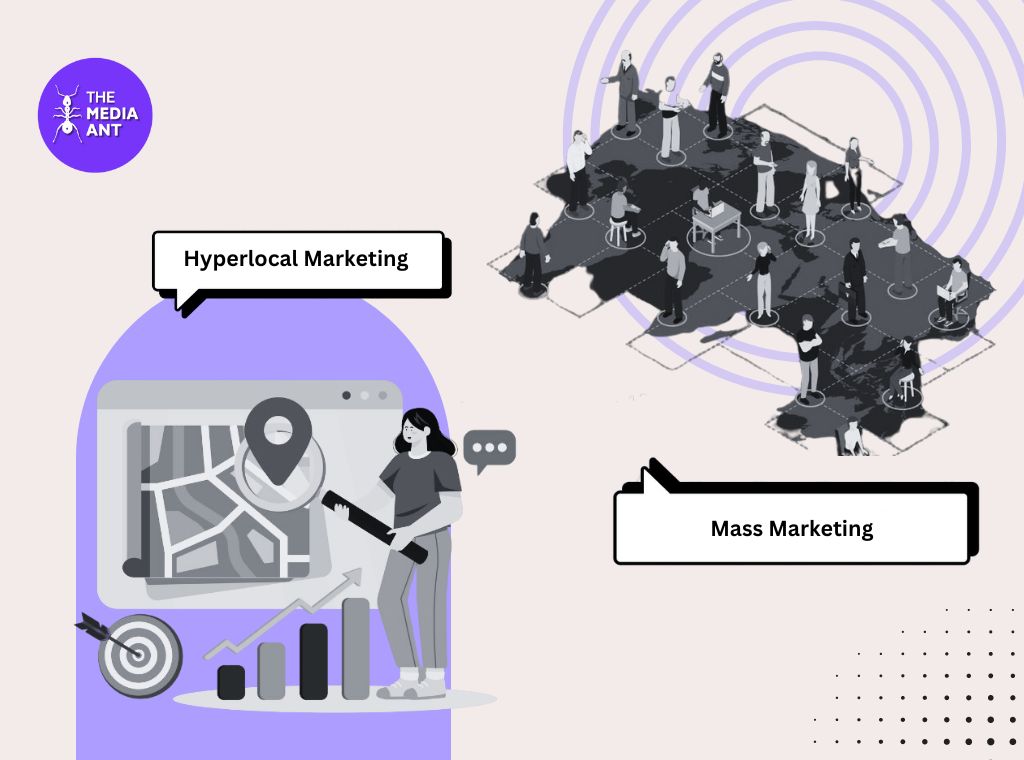Today, the world is characterized by several forms of marketing and advertising factors and companies are usually indecisive while selecting the most appropriate method to use in reaching their target markets. Two major strategies are utilized in this context, which are hyperlocal marketing and mass marketing and both are useful in different ways utilizing a different set of techniques to target the consumer.
Hyperlocal marketing operates at the community or neighborhood level where communications, messages and even campaigns are customized based on culture, taste and requirement of the area. This strategy is quite helpful to those businesses that are keen on ensuring that they have a proper anchor in the local market and that they make direct contact with the people in the immediate neighborhood.
In contrast, mass marketing targets a larger audience and is spread across vast geographical regions in its attempt to lure people. Such an approach is more popular among the brands that seek to gain top-of-mind awareness and advertise their products or services on a national and even international level. The decision to go hyperlocal marketing vs mass marketing depends on several factors like the business needs, the capital required, the type of goods and services to be marketed and the level of coverage required.
Difference Between Hyperlocal Marketing Vs Mass Marketing
| Particulars | Hyperlocal Marketing | Mass Marketing |
| Definition | Concentrated and mostly turns its attention to the consumers who reside in a specific locality or a neighborhood. This type of marketing usually seeks to develop intimate and specific customized association with masses. | Efforts to produce content or some form of media message to find appeal with as many people as possible without focusing on certain variables such as location or age. It is more or less an approach that focuses on reaching out to a high number of consumers within the shortest period of time, at times across the country or across the world. |
| Audience Scope | Involves a rather limited and well identified number of people in a given geographical region. Most often the audience is within a walking or a short driving distance from the business or event in question. | Has a broad coverage of the market comprising a large number of clients within various areas or countries with different tastes and needs. |
| Customization | Structured in a manner that incorporates the dialects, landmarks, and major themes that are relevant in the culture and area of operation of the target audience. | Depends on general messages which are meant to be appealing to several people in the population. These messages have to be free from regional and cultural barriers so that the overall image of the brand is consistent. |
| Channels Used | May incorporate common means such as, local newspapers, community billboards, local online forums, which target a specific region only. Word of mouth contacts at functions, fairs or bazaars are also common. | Utilizes the mainstream media which include national television and radio, leading newspapers and any digital media outlet that has high reach, with an intention of influencing a sizable population of consumers at a single instance. |
| Marketing Message | Creates messages that might be most suitable for the place of the business operations especially in terms of celebrating local achievements, local reference or even local holiday special offers. | Creates appeals that should not be too specific to some segments of audience but emphasizes more on the utility and characteristics of a product or a service. |
| Cost | They are usually less expensive than mass communication since they are targeted and others do not need several resources to get to the targeted group. | They involve a lot of costs to organize due to the size of the event and the different types of media to cover in order to get maximum coverage. |
| Objective | Also used to target the local community with the intention of creating an instant traffic and sales conversion, common for the small businesses or outlets which are in a need of increased visitors and/or awareness. | Anticipated to create unsubscribing brand images and generate large scale sales; suitable for non-geographically restricted products and services. |
| Engagement | Usually gets more click-through rates mainly owing to the fact that it is more appropriate and engulfs the audience in a certain sort of community activity. | Could potentially find difficulty in reaching the target of engaging users at a deep level per user since its approach is rather extensive and non-targeted and is more of branding, rather than direct involvement. |
| Measurement | This means that it provides immediate feedback of the local folks thus easier to evaluate the success of a campaign through direct client interaction and local point of sale data. | It frequently involves intricate and comprehensive assessment of the market in terms of impact within and across various geographic and demographic segments relying on quantitative as well as qualitative research. |
| Examples | A signing at a bookstore may be arranged with a local writer and advertising may include fliers in the community and facebook posts posted on local neighborhood wall pages. | An international smartphone maker rolls out a new model which is backed by popular international actors and is advertised widely across television, social and print media in several countries. |





